In English:
Loviisa is small town with nearly 16000 habitants. It got its name according to the Swedish queen Louisa Ulrika of Prussia (1720 – 1782). It is situated from Helsinki to the East and by car it takes less than one hour to reach it. There is not so much to see, but its old quarter of wooden houses is interesting. Many of them have seen better days, but it happens.
The red brick church of Loviisa was built 1863–1865. It style is neo-gothic style and its capacity is 1000 visitors. There is no altar painting, but instead of it, there is the Christ statue, which is a plaster copy of the Danish Bertel Thorvaldsen’s work from the year 1839. I visited inside it, took photos and the young guide had a surprise to visitors. Young Lady Salla played Kantele in church for visitors. Kantele is our national instrument. This Kantele that Salla played had 39 strings. My ten last photos I captured from the video which I made for YouTube.
Enjoy the visit with me thru my photos.
En español:
Loviisa es pequeña ciudad y tiene aproximadamente de 16000 habitantes. Obtuvo su nombre segun de la reina sueca Luisa Ulrica de Prusia (1720 – 1782). Esta situada de Helsinki hacia el Este y en carro se tarda manejar menos de una hora para llegar allí. No hay mucho que ver, pero el barrio viejo con sus viejas casas de madera es interesante. Muchos de ellas han visto días mejores, pero eso es lo que pasa a veces.
La iglesia de ladrillo rojo de Loviisa se construyó 1863-1865. Su estilo es neo-gótico y la capacidad es para 1000 visitantes. No hay pintura del altar, sino que, hay una estatua de Cristo, que es una copia de yeso de la obra del danés Bertel Thorvaldsen del año 1839. Visité el interior de la iglesia sacando mis fotos y la guía jóvencita Salli tenía una sorpresa para dar a los visitantes. Ella jugó Kantele en la iglesia para los visitantes. Kantelees nuestro instrumento nacional. Este Kantele que Salla jugó había 39 cuerdas. Mis diez últimas fotos capturó del video que hice para YouTube.
Disfrute Vos de la visita conmigo a través de mis fotos.
En francais:
Loviisa est une petite ville avec près de 16000 habitants. Ella a obtenu son nom selon la reine suédoise Louise-Ulrique de Prusse (1720 – 1782). Loviisa est située d’Helsinki à l’Est environ une heure en voiture. Il n’y a pas tellement beaucoup à voir, mais ses vieilles maisons en bois dans le vieux quartier sont intéressantes. Beaucoup d’entre elles ont connues meilleurs jours, mais cela arrive quelquefois dans notre vie.
Eglise de Loviisa faite de briques rouges a été construite entre 1863 à 1865. Elle est de style néo-gothique et sa capacité est pour 1000 visiteurs. Il n’ya pas de tableau d’autel, mais au lieu de cela, il y a la statue du Christ, qui est une copie de travail en plâtre par danois Bertel Thorvaldsen de l’année 1839. J’ai visité l’intérieur de l’église, pris des photos et le jeune guideSalla a eu une surprise. Elle a joué dans l’église Kantelepour les visiteurs. Kantele est notre instrument national. Kantele que Salla avait joué á 39 cordes. Mes dix dernières photos que j’ai capturé de ma vidéo que j’ai faite pour YouTube.
Je Vous souhaite une très agréable visite à travers mes photos.
Other towns with old wooden houses: / Otras ciudades con antiguas casas de madera: / Autres villes avec des vieilles maisons en bois:
Rocks and villas of Hanko / Rocas y villas de Hanko/ Roches et villas de Hanko
Charming wintry Porvoo / Encantador Porvoo en invierno / Charmant Porvoo en hiver
Old Rauma / Vieja Rauma / Vieille Rauma
Old sleepy town / Tranquila Ciudad vieja / Vielle ville somnolente
Walking in Naantali / Caminando en Naantali / Balade á Naantali
Idyllic Kristinestad / Idílica Kristinestad / Kristinestad idyllique
Video:































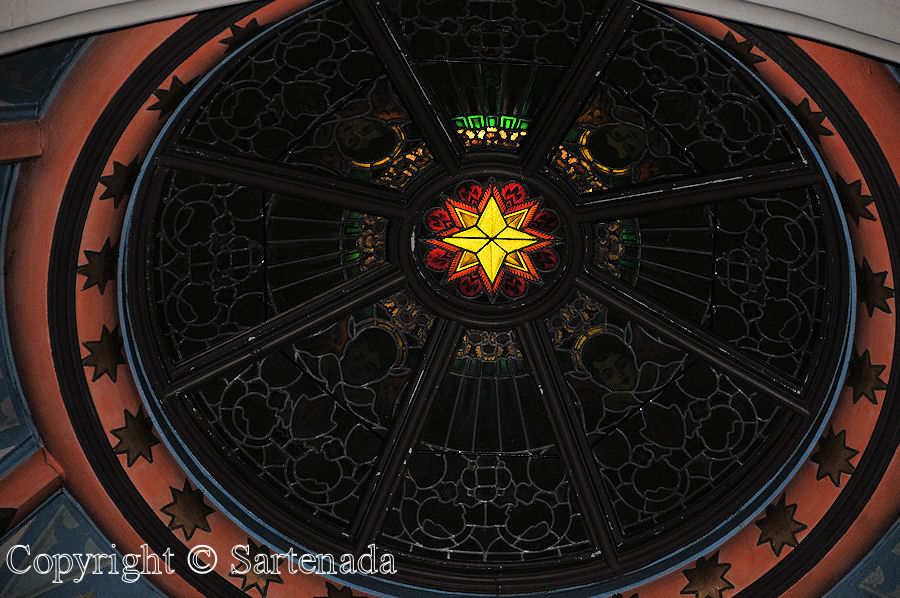





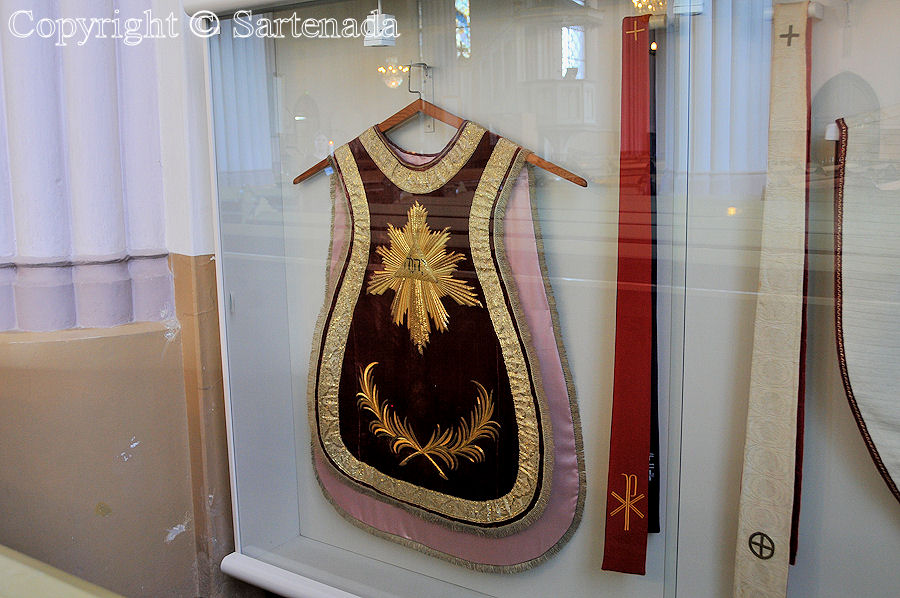
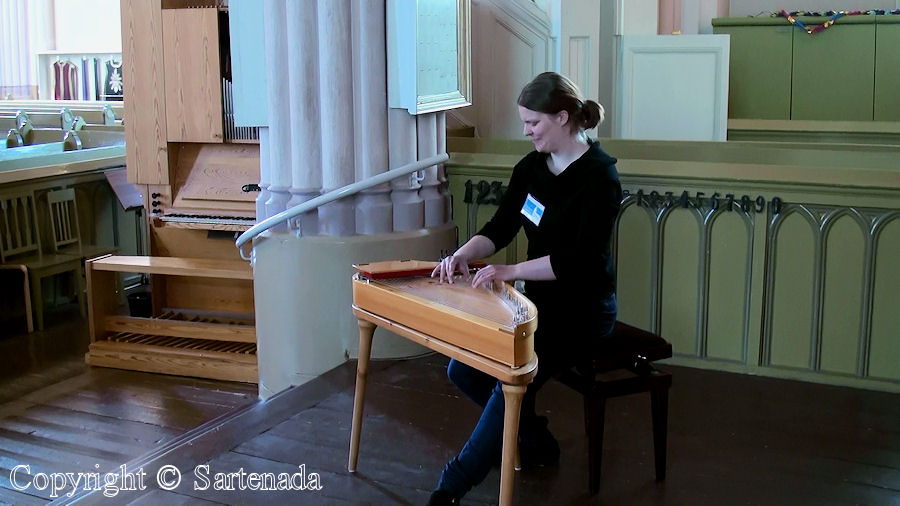
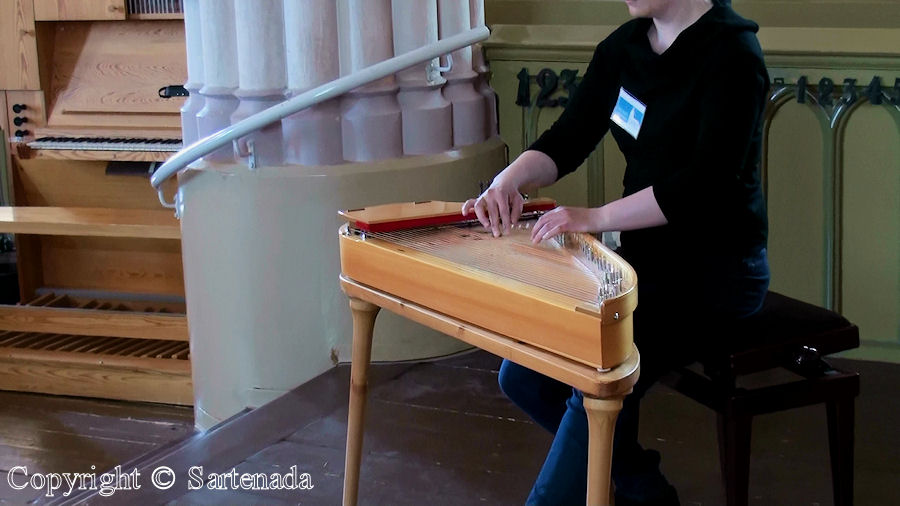



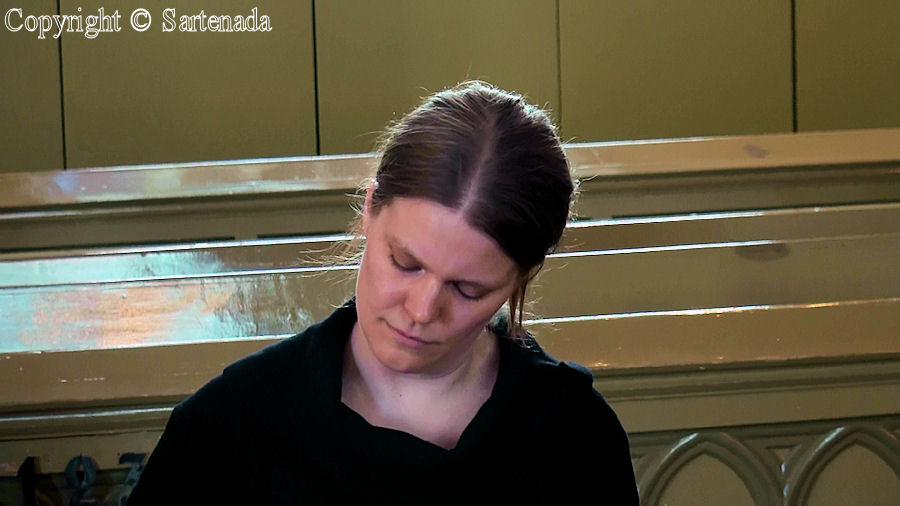


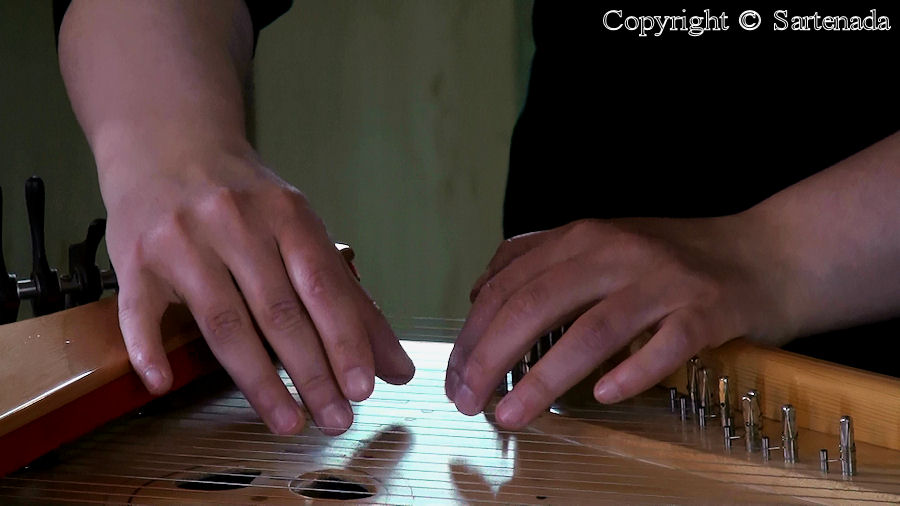

Beautiful images of the town. I did enjoy the tour.
Comment by lsvejda — September 23, 2011 @ 14:44 |
Hello Isvejda.
Thank You giving Your time to visit on my site and leaving nice comment. I am so glad that this small town with wooden houses thru my photos pleased You.
Have a lovely day!
Comment by sartenada — September 23, 2011 @ 14:53 |
I love how people in Finland cherish and preserve what is a part of their history. In my city everything that is over 30 or so years old gets torn down for “progress.” With your photos, I can imagine people going about their daily lives in this old town, You’ve captured the ambience of the church so beautifully – you can hear the hush in your pictures. The photos from your video so beautifully show Salla’s rapt attention and the grace of her hands as she plays. You’ve given me a delightful start to a rainy Friday morning here at home. Janet
Comment by harpingjanet — September 23, 2011 @ 16:43 |
Hello Janet.
Thank You. We have old town with wooden houses and some of them are well preserved. Personally I love Old wooden houses in Pispala in Tampere. I am especially glad that watched the video. You know very well if this kind of musical instrument is easy to play or not. Harp is majestic instrument and its sound goes direct to one’s soul.
Have a wonderful day!
Comment by sartenada — September 24, 2011 @ 09:14 |
Beautiful photos, as always. It’s so interesting how the wooden buildings are so long and set closely without a lot of vegetation. It looks almost military and quaint at the same time.
Comment by Tammy — September 24, 2011 @ 20:05 |
Hello Tammy.
Thank You. I am so glad that my photos pleased You. Your idea, that it is looking like military, is so right. Originally Loviisa was founded specifically to the border, and the fortress town. Sorry, that I forget to mention it in foreword.
Have a lovely day!
Comment by sartenada — September 25, 2011 @ 08:29 |
Wow! What a colorful and lovely village Loviisa is! And I really like the town name, too. Those cobblestone streets are wonderful and I would just love to walk around the town. I haven’t seen the musical instrument, Kantele, before, and what an interesting string instrument. I enjoyed the tour with your photo series. 🙂
Comment by Anna — September 24, 2011 @ 23:53 |
Hi Anna.
Cobblestone streets are vanishing slowly, sob. They are part of old history which can be seen now, but after few years… Thank You commenting and I am glad that Kantele was interesting too in Your eyes.
Happy Sunday!
Comment by sartenada — September 25, 2011 @ 08:34 |
What a beautiful church, I loved the organ pipes and the painted archway was just gorgeous…the stained glass windows as well. Just like Anna I noticed the cobblestone streets, you are so lucky to have such history at your fingertips Matti!
Have a lovely week 🙂
Comment by convictstock — September 25, 2011 @ 10:07 |
Hello Convictstock.
Thank You. I am always “afraid” to present churches, although my digital photographing stared with them in 2004. So, I thought that now I had good opportunity to show this church when presenting old town of Loviisa. When presenting churches, I divide in different categories like: stone churches, wooden churches, red brick churches, Orthodox churches, Cathedrals and monasteries. I think that it is quite good way to divide they in this way, because then they do not” hurt” anyone belonging to a “different” religion.
Have a lovely Sunday!
Comment by sartenada — September 25, 2011 @ 11:57 |
ps. I like your new avatar! Did the car get retired?
Comment by convictstock — September 25, 2011 @ 10:15 |
Hi again Convictstock.
You made a very good question. Well, after having nearly two years the same avatar, I thought that people are tired to “stare” at my blue car. My car is still going strong and fast :). It has served me since January 2007 faithfully. I have driven with it zigzagging in Finland, in Norway, in Germany, in Austria, In Switzerland and in Liechtenstein. Until now no problems with it!
The avatar I looked one hour from my computer and decided to select smiling carved wooden bear. I took it in Inari, which is beyond the Arctic Circle to the North 326 kilometers / 202 miles. My series from my holiday, I’ll start in the beginning of 2012.
Thank You asking and I am so glad, that it pleased to You.
Comment by sartenada — September 25, 2011 @ 12:08 |
Very beautiful series Matti ! The stained glass art is really fantastic, so crisp and clear !!! Very very nice work. Also that instrument is very interesting…
Have a wonderful weekend 🙂
Comment by Tamara — September 25, 2011 @ 10:54 |
Hello Tamara.
I am so happy that You found something beautiful from my post and left You nice comment. Thank You.
Have a lovely day!
Comment by sartenada — September 25, 2011 @ 12:10 |
I would love to explore this little town.
It’s small but it’s full of surprises.
Just like the church!
I cannot imagine this little town can have such a huge church!
I have never seen kantele before!
It looks like blend between a harp and a piano. 🙂
Comment by London Caller — September 25, 2011 @ 16:40 |
Hello London Caller.
Your comment sounds so good to me. Thank You.
Salla told to me that many Japanese tourists are very interested in Kantele, because in Japan they have Koto. Also I have read that Kantele is played U.S.A. I am sure that it is not so easy to play; same is valid for Harp. Especially I love the musical sound of Venezuelan Harp, but I love South American rhythms.
Happy Sunday!
Comment by sartenada — September 25, 2011 @ 16:52 |
Guten Morgen Matti,
The old city is impressive and interesting. The colorful facades of the houses enliven the cityscape. Figures 5 and 10 are my favorites. In Figure 5 I like the garden including the house. It looks very romantic. In Figure 10 I like the brown paint on the facade of the house, including the front view. Here too, conveys the sight of harmony. The restaurant in figure 17 would be interesting to see the inside. I think that you can comfortably enjoy a meal there. Now the church. The church is located in a beautiful environment. The first three images are a good introduction to the pictures below. The interior of the church has subtly and harmoniously.
The dome over the statue of Christ including the background is beautiful. It is the eye catcher in this church. Even the stained glass windows I like very much. It is falling from the outside, lots of natural light into the space inside the church. Of the organ in Figure 20, I am also very impressed. It works beautifully in bright colors. The golden luster of the pipes is fantastic for expression. The surprise that Salla kantele playing for the visitors, was a good idea. Above all else, you accurately photographed every finger movement during Salla played the instrument. I listened to the sounds of the kantele and found it a pleasant conclusion to this interesting series. I am grateful for the fact that I was allowed to participate in this series again. I wish you and Anya all the best, health and happiness to your everyday common paths. Thank you for all the kind comments and stars in between under the photos in my blog. Take care, my friends.
Dear greetings from Christel
Comment by Christel — September 28, 2011 @ 01:05 |
Guten morgen Christel.
I see from Your lovely comment that You really took long time to explore my post. I am very glad that You listened to the sound of Kantele. To us, Kantele is important instrument to us. Our world is changing, as You know, but to have something original is important. Kantele is one and Himmeli is another.
Thank You very much.
Viele Grüße.
Comment by sartenada — September 28, 2011 @ 06:50 |
You have shown us another beautiful city Matti. I just love seeing the structures in your country! The church is magnificent. Its simplicity is truly elegant, and everything in it shows reverence and respect: the stained glass is wonderful. I also like the Kantele: I would love to hear it played in person.
Comment by montucky — September 28, 2011 @ 04:01 |
Hello Montucky.
I am so glad that You liked my post. When presenting small towns, it is not so easy to find what to show. I guess that this time succeeded well. The sound of Kantele is in real life really beautiful and its sound in video with sound cannot compete real life experience.
Thank You.
Comment by sartenada — September 28, 2011 @ 06:56 |
What wonderful photos! The Church of Loviisa is just magnificent.The stained glass windows are absolutely beautiful.
Thank you so much for visiting my blog, and for introducing me to yours.
Comment by alskamom — September 29, 2011 @ 00:27 |
Hello Alskamom.
Thank You to You also visiting my site and leaving so nice comment.
Have a wonderful day!
Comment by sartenada — September 29, 2011 @ 06:26 |
Very well captured…felt like I had actually talked through the town
Comment by ashkitty — September 30, 2011 @ 17:12 |
Hello Ashkitty.
That was so nicely said. That was really my purpose and now I see that I succeeded.
Thank You very much. Have a lovely week-end!
Comment by sartenada — October 1, 2011 @ 09:25 |
I enjoyed this tour in the old town Loviisa. And I know Bertel Torvaldsen, he is a famous Danish sculptor.
You can read more about him here:
http://en.wikipedia.org/wiki/Bertel_Thorvaldsen
and his works can be seen many places in the world – also here in Denmark. He has a museum for his works in Copenhagen:
http://en.wikipedia.org/wiki/Thorvaldsens_Museum
Comment by truels — October 4, 2011 @ 20:08 |
Hello Truels.
Thank You. I am glad that You liked my photos from this small town and at the same time You found something “familiar” to You. Bertel seems to be great artist and I am very glad that we honored him thru the statue of Christ.
Have a lovely day!
Comment by sartenada — October 5, 2011 @ 06:16 |
A wonderful tour of the old town with a beautiful church ~ excellent photography!
We can’t find this type of wooden houses in Singapore..I love the quietness and space..
Comment by Anne — October 7, 2011 @ 11:38 |
Hi Anne.
Thank You. If You do not have this type of old wooden houses in Singapore, well, I know it because I have been once in Singapore, but You have great buildings and so much to see and to experience. Singarore is wonderful tropical country and CLEAN.
Comment by sartenada — October 7, 2011 @ 12:00 |
The ceiling in the church is reminiscent of those at St. Mary Cathedral in Austin and the Immaculate Conception Cathedral in Brownsville– both places in Texas.
My thought on seeing the young woman with the instrument is what comes to mind whenever we see our #1 son, a professional musician, play his electric bass. The fingers must hurt! But, oh, the music!
Great job on the photos, Matti!
Comment by Deli Lanoux, Ed.D. — October 10, 2011 @ 19:32 |
Hello Deli.
Thank You for visiting and commenting this post. It was very interesting that You found “similarities” with two churches in Texas and with this one! I guess, but not being sure, that for example this red brick church has “universal” architecture. My favorite churches are yet small wooden churches on country side far away from big cities.
I did not ask if Salla’s fingers heart, maybe when she started to learn. Nice to hear that Your son is playing bass.
Have a lovely week.
Comment by sartenada — October 11, 2011 @ 06:36 |
Good morning, I greatly enjoyed your visit around this cozy town. I could imagine to spend a relaxing holiday in this quiet surrounding. Many thanks also for having introduced me to the instrument Kantele. We’ve a similar instrument that is called “Zitter” (in German) We’ve quite awful weather with a lot of snow and rain so there is not much sun! Anyway, I wish you a very good day. Bye Martina
Comment by Martina Ramsauer — January 31, 2014 @ 09:25 |
Hi Martina.
Thank You for Your comment and telling about Zither. So it is proven that music and instruments are universal. It was nice to read that You love the old town of Loviisa. We have many “similar” towns which have old wooden historic houses.
Have a lovely day!
Comment by Sartenada — January 31, 2014 @ 11:06 |
Such a charming and quaint town Sartenada Dear!
Loved all the superb photos and I particularly enjoyed the interior architecture of the church with the wonderful stained glass windows and the divine statues!I’m writing my comment while listening to the sweet Kantele melodies!Thanks kindly for the suggested link,I so much enjoyed your wonderful post!
All the very best! ~ Happy Easter ~ , Doda 🙂
Comment by DG MARYOGA — April 3, 2015 @ 17:58 |
Hi Doda.
Wonderful comment. Thank You. In Finland we have few towns on our coastal line which have residential areas with the old romantic wooden houses. Later this year I will present one more of these towns.
Here are my earlier posts excluding Loviisa presenting these old town worth for a visit:
Charming wintry Porvoo
Old Rauma
Tammisaari – old sleepy town
Walking in Naantali
Old wooden houses in Pispala
Idyllic Kristinestad
Old wooden houses in Mikkeli
Have a wonderful day!
Comment by Sartenada — April 4, 2015 @ 10:35 |
Beautiful photographs of the town & church. Thanks also for posting those photos of you playing the kantele. A gorgeous instrument to be sure.
Thank you also for stopping by my blog…
Comment by neuroyogi — May 20, 2018 @ 11:08 |
Ooops – I realized it is a friend laying the instrument. 39 strings. Amazing.
Comment by neuroyogi — May 20, 2018 @ 11:11 |
🙂
Comment by Sartenada — May 20, 2018 @ 11:48 |
Hello neuroyogi.
Thank you for Your kind words and loving my post.
Have a nice day!
Comment by Sartenada — May 20, 2018 @ 11:48 |